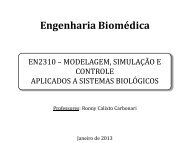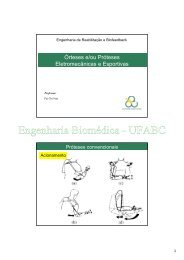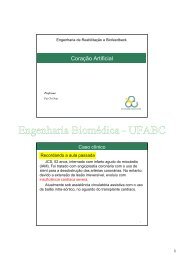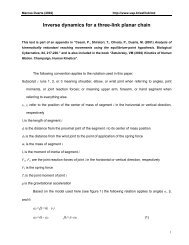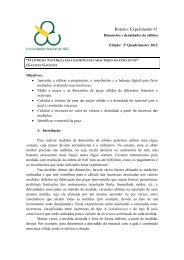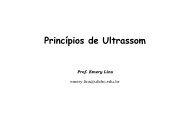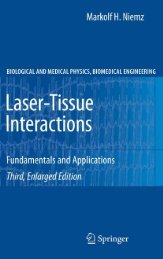Long-range correlations in human standing
Long-range correlations in human standing
Long-range correlations in human standing
- No tags were found...
Create successful ePaper yourself
Turn your PDF publications into a flip-book with our unique Google optimized e-Paper software.
7 May 2001Physics Letters A 283 (2001) 124–128www.elsevier.nl/locate/pla<strong>Long</strong>-<strong>range</strong> <strong>correlations</strong> <strong>in</strong> <strong>human</strong> stand<strong>in</strong>gMarcos Duarte a,∗ , Vladimir M. Zatsiorsky ba Universidade de São Paulo, Av. Mello Moraes 65, 05508-900, São Paulo, SP, Brazilb Biomechanics Laboratory, Pennsylvania State University, 39 Rec. Build<strong>in</strong>g, University Park, PA 16802, USAReceived 4 September 2000; received <strong>in</strong> revised form 2 February 2001; accepted 9 March 2001Communicated by A.P. FordyAbstractWe estimated long-<strong>range</strong> <strong>correlations</strong> <strong>in</strong> the dynamics of sway dur<strong>in</strong>g prolonged <strong>human</strong> stand<strong>in</strong>g. Two methods were used<strong>in</strong> this estimation: detrended fluctuation analysis (DFA) and power spectral analysis. Both methods yielded similar results: weobserved long-<strong>range</strong> <strong>correlations</strong> with s<strong>in</strong>gle scal<strong>in</strong>g exponents over a broad <strong>range</strong>, from 10 s to 10 m<strong>in</strong>, of stand<strong>in</strong>g. © 2001Elsevier Science B.V. All rights reserved.PACS: 87.10.+eKeywords: Humans; Biology; Balance; Fractals; 1/f noise1. IntroductionS<strong>in</strong>ce <strong>human</strong>s adopted their bipedal stance, theyhave been challenged to ma<strong>in</strong>ta<strong>in</strong> equilibrium of thebody over a small area of support. Only when the abilityto control the upright stance deteriorates, as forexample <strong>in</strong> elderly people and <strong>in</strong> certa<strong>in</strong> pathologies(e.g., vestibular disorders and stroke), does one realizehow difficult and crucial this task is. Ma<strong>in</strong>ta<strong>in</strong><strong>in</strong>g balanceis a complex task achieved by <strong>in</strong>tegrat<strong>in</strong>g varioustypes of sensory <strong>in</strong>formation (visual, vestibular, andsomatosensory) and rely<strong>in</strong>g on the passive propertiesof the musculo-skeletal system. A remarkable exampleof the <strong>human</strong> efforts to understand postural control* Correspond<strong>in</strong>g author.E-mail addresses: mduarte@usp.br (M. Duarte),vxz1@psu.edu (V.M. Zatsiorsky).URL address: http://www.usp.br/eef/efb/mduarte/ (M. Duarte).is the study on adaptation to microgravity environmentperformed by a space shuttle crew [1].When asked to stand quietly, <strong>human</strong>s do not staymotionless — they sway. This sway is usually recordedwith a force platform, a measur<strong>in</strong>g device on which thesubjects stand dur<strong>in</strong>g the experiments. The most commonvariable to analyze this sway is the location ofthe center of pressure (COP), the po<strong>in</strong>t of applicationof the resultant of vertical forces act<strong>in</strong>g on the surfaceof support. The COP displacement represents a collectiveoutcome of the postural control system and theforce of gravity [2]. The COP displacement over shortperiods of time (1 m<strong>in</strong>) dur<strong>in</strong>g quiet stance has beenmodeled as a random walk process, <strong>in</strong>terpret<strong>in</strong>g theoutcome of the posture control system as a stochasticprocess rather than as a determ<strong>in</strong>istic one [3]. It wasreported that COP displacement was persistent up toabout <strong>in</strong>tervals of 1 s (positive <strong>correlations</strong>), and for<strong>in</strong>tervals of 1 to about 10 s an anti-persistent behaviorwas present (negative or anti-<strong>correlations</strong>). Basedon the boundaries of the base of support dur<strong>in</strong>g mo-0375-9601/01/$ – see front matter © 2001 Elsevier Science B.V. All rights reserved.PII: S0375-9601(01)00188-8
M. Duarte, V.M. Zatsiorsky / Physics Letters A 283 (2001) 124–128 125tionless stand<strong>in</strong>g, the authors hypothesized that theprocess should saturate at the region of 10 to 30 s,i.e., no long-<strong>range</strong> <strong>correlations</strong> for time <strong>in</strong>tervals above30 s were expected dur<strong>in</strong>g quiet stance; but the authorsrecognized that longer time series were necessary fora f<strong>in</strong>al conclusion [3]. Recently, an analysis of quietstand<strong>in</strong>g by wavelet statistics has shown different scal<strong>in</strong>gregions (multifractal) <strong>in</strong> short time series [4].One shortcom<strong>in</strong>g <strong>in</strong> the studies of <strong>human</strong> stand<strong>in</strong>gis that quiet stance tasks with the <strong>in</strong>struction “to stayas still as possible” are limited to only a few m<strong>in</strong>utesdue to fatigue. On the contrary, natural stand<strong>in</strong>g overprolonged periods, longer than few m<strong>in</strong>utes, is a verycommon situation <strong>in</strong> daily life, such as stand<strong>in</strong>g <strong>in</strong>l<strong>in</strong>e, or stand<strong>in</strong>g while talk<strong>in</strong>g with somebody. Thisstand<strong>in</strong>g is characterized by repeated changes <strong>in</strong> thebody position, which are self-<strong>in</strong>duced, performed almostunconsciously, and cannot be generally associatedwith any external source. Such natural stand<strong>in</strong>g isnot fatigu<strong>in</strong>g and can be reproduced <strong>in</strong> the laboratoryby a stand<strong>in</strong>g task dur<strong>in</strong>g which a person is allowedto do any movement without any constra<strong>in</strong>t, except tostay with<strong>in</strong> the limited area of the force plate. This unconstra<strong>in</strong>edstand<strong>in</strong>g <strong>in</strong> healthy adults was exam<strong>in</strong>edby Duarte and Zatsiorsky [5] who observed very lowfrequencies <strong>in</strong> the displacement of COP dur<strong>in</strong>g unconstra<strong>in</strong>edstand<strong>in</strong>g, a typical signature of a long-<strong>range</strong>correlation process or long-memory process. Recently,Duarte and Zatsiorsky [6] used the classical rescaledadjusted <strong>range</strong> analysis or R/S statistic [15] to describethe fractal properties of the COP time seriesdur<strong>in</strong>g natural stand<strong>in</strong>g. The average fractal or Hurstexponent (H )was0.35 ± 0.06. In this Letter, weused more robust methods and performed a surrogatetest to quantify the long-<strong>range</strong> correlation phenomenadur<strong>in</strong>g prolonged periods of unconstra<strong>in</strong>ed stand<strong>in</strong>g.<strong>Long</strong>-<strong>range</strong> correlation processes present very longtermfluctuations <strong>in</strong> addition to very short-term fluctuations,where the dependence of data farther apart ishigher than it is expected for <strong>in</strong>dependent data. Thisphenomenon has been observed <strong>in</strong> very diverse areasof nature. Related to biological systems and specificallyto <strong>human</strong>s, it has been observed <strong>in</strong> stride <strong>in</strong>tervalsdur<strong>in</strong>g walk<strong>in</strong>g [7], <strong>human</strong> cognition [8], <strong>in</strong>tervalsbetween rhythmic tapp<strong>in</strong>g movements [9], heartbeatvariability [10,11] and certa<strong>in</strong> DNA sequences[12,13].2. MethodsIn this study, ten healthy subjects (28 ± 5yr,1.79 ±0.09 m, and 78 ± 14 kg) were asked to stand <strong>in</strong> an unconstra<strong>in</strong>edupright bipedal posture on a 40 × 90 cmforce plate for 30 m<strong>in</strong> (the methods were described <strong>in</strong>detail elsewhere [5]). We analyzed the COP trajectoriesfor the anterior–posterior (a–p) and medial–lateral(m–l) direction. Examples of stabilograms (the mapp<strong>in</strong>gof COP a–p versus COP m–l) and a exemplarytime series are shown <strong>in</strong> Fig. 1.The stochastic model of fractional Gaussian noise(or the <strong>in</strong>tegrated function, fractional Brownian motion)is an example of a self-similar process (like afractal) appropriate to model such long-<strong>range</strong> correlationphenomena. This model has been successfullyused <strong>in</strong> many of the above examples and it was usedhere. Several heuristic methods have been suggestedto estimate long-<strong>range</strong> <strong>correlations</strong> s<strong>in</strong>ce the classicalR/S statistics proposed by Hurst <strong>in</strong> hydrology context(for a review of models and methods, see [14]).Two methods were used to estimate long-<strong>range</strong> <strong>correlations</strong>:power spectral analysis (PSA) [14], performed<strong>in</strong> the frequency doma<strong>in</strong>, and detrended fluctuationanalysis (DFA) [10], performed <strong>in</strong> the time doma<strong>in</strong>.The PSA method <strong>in</strong>volves plott<strong>in</strong>g the power spectraof a sample path on a log–log scale. If the samplepath presents long-<strong>range</strong> <strong>correlations</strong> over a <strong>range</strong>of frequencies then significant l<strong>in</strong>ear regression <strong>in</strong> thelog–log plot captures the relation between frequencyand power of the type 1/f −β ,wheref is the frequencyand β is the scal<strong>in</strong>g exponent. The exponentβ is 0 for white noise, −1 for1/f noise, and −2 forBrownian noise.The DFA method is a modification of the root-meansquare analysis of a random walk [15] and it is lesssensitive than the PSA method to possible nonstationaritiesand noise <strong>in</strong> the data such as the COP displacementdur<strong>in</strong>g unconstra<strong>in</strong>ed stand<strong>in</strong>g. For a randomwalk process, the net displacement of a walker afterk steps is y(k) = ∑ ki=1 u(i),whereu(i) is a samplepath of a random walk process or a Brownian motion.Us<strong>in</strong>g the DFA method, the <strong>in</strong>tegrated sample path, y,of total length N is divided <strong>in</strong>to w<strong>in</strong>dows of length l;each w<strong>in</strong>dow steps forward by an <strong>in</strong>terval l/s, wheres is the overlapp<strong>in</strong>g parameter set to 2 <strong>in</strong> the presentstudy, and N/(l/s) is the total number of w<strong>in</strong>dows.For each w<strong>in</strong>dow, the local trend is estimated by a l<strong>in</strong>-
126 M. Duarte, V.M. Zatsiorsky / Physics Letters A 283 (2001) 124–128Fig. 1. Position of the subjects on the force plate and axes convention (a). Two examples of stabilograms dur<strong>in</strong>g a 30 m<strong>in</strong> PUS: multi-region (b)and s<strong>in</strong>gle-region stand<strong>in</strong>g (c). Exemplary COP time series (d).ear least-squares fit, ŷ, and the curve is subsequentlydetrended. The variance of each w<strong>in</strong>dow’s detrendedsample path is calculated. The root of the mean variancesof all w<strong>in</strong>dows of length l is the detrended fluctuation,F ,ofthewalker:√F(l)=√ l/sNN/(l/s)∑n=11ll∑ [ ] 2.y(k)−ŷ(k)k=1The root-mean square fluctuations <strong>in</strong>crease with l,andif there is a l<strong>in</strong>ear relationship <strong>in</strong> a log–log scale of Fwith l, the data obey a power-law function, F(l)∼ l α ,where α is the scal<strong>in</strong>g exponent quantify<strong>in</strong>g the long<strong>range</strong><strong>correlations</strong>. For white noise, the exponent αis 0.5, for 1/f noise it is 1, and 1.5 for Brownian noise.For data with <strong>in</strong>f<strong>in</strong>ite length, the exponents α and β arerelated by the expression β = 1 − 2α [16].3. Results and discussion<strong>Long</strong>-<strong>range</strong> <strong>correlations</strong> for the COP data wereanalyzed for lags/w<strong>in</strong>dow lengths greater than 10 sand up to one-third (10 m<strong>in</strong>) of the 30 m<strong>in</strong> data. Thelower limit was selected to ignore the already reportedshort-<strong>range</strong> <strong>correlations</strong> for quiet stance <strong>in</strong> the <strong>range</strong>of 1 s [3]. The upper limit was chosen to obta<strong>in</strong>three <strong>in</strong>dependent sets of data, <strong>in</strong> order to <strong>in</strong>crease thestatistical power of the results. The fitted l<strong>in</strong>e for eachtrial <strong>in</strong> the region of 10 s to 10 m<strong>in</strong> represent<strong>in</strong>g thescal<strong>in</strong>g exponent (slopes) obta<strong>in</strong>ed by the DFA andPSA methods are shown <strong>in</strong> Fig. 2. The α exponentswere 0.98 ± 0.17 and 1.01 ± 0.26 for the a–p andm–l directions, respectively. The β exponents were−1.00 ± 0.42 and −1.27 ± 0.63 for the a–p andm–l directions, respectively. These results satisfiedthe relation β = 1 − 2α and <strong>in</strong>dicated the presenceof nontrivial long-<strong>range</strong> <strong>correlations</strong>. Because thereported values were less than the values for Brownianmotion, the <strong>correlations</strong> were <strong>in</strong> fact anti-<strong>correlations</strong>(negative <strong>correlations</strong>).The variability of α (expressed by the mean standarddeviations) was about 2.5 times lower than thevariability of β. As expected, this <strong>in</strong>dicated that theDFA method yielded more robust results that were lesssensitive to nonstationarities. The average value of αfor the COP data <strong>in</strong> the a–p and m–l directions was1.00 ± 0.22 (<strong>range</strong>: 0.68–1.47), which is equivalent to
M. Duarte, V.M. Zatsiorsky / Physics Letters A 283 (2001) 124–128 127Fig. 2. DFA exponents α (a) and PSA exponents β (b). Th<strong>in</strong> l<strong>in</strong>esare the slopes for the ten subjects and both directions for lags greaterthan 10 s or frequencies smaller than 10 −1 Hz (<strong>in</strong>dicated by thedashed arrows). The median values are shown with thick l<strong>in</strong>es. Thel<strong>in</strong>es and values of the scal<strong>in</strong>g exponents for white and Browniannoise are shown for comparison (dashed l<strong>in</strong>es).the value α = 1for1/f noise, as shown <strong>in</strong> Fig. 2. Thereported <strong>range</strong> of the scal<strong>in</strong>g exponents for differentsubjects may suggest that the observed long-<strong>range</strong> <strong>correlations</strong>are not only a verification of the ubiquity of1/f noise <strong>in</strong> the nature but rather a phenomenon manifest<strong>in</strong>gdifferently across healthy adult subjects.To determ<strong>in</strong>e the statistical significance of theresults for long-<strong>range</strong> <strong>correlations</strong>, a surrogate testwas performed [17]. To this end, ten new samplepaths were created by randomly shuffl<strong>in</strong>g the orig<strong>in</strong>alsample path; the created sample paths had the samemean and variance as the orig<strong>in</strong>al ones but shouldhave no long-<strong>range</strong> <strong>correlations</strong>, <strong>in</strong>dicated by α = 0.5and β = 0. Compar<strong>in</strong>g the mean of the scal<strong>in</strong>gexponents for the set of shuffled data with the meanof the orig<strong>in</strong>al sample path, the difference betweenthe scal<strong>in</strong>g exponents was well above three standarddeviations, for each of the ten subjects and for bothmethods. Therefore, the hypothesis of long-<strong>range</strong><strong>correlations</strong> was accepted.To test if the observed long-<strong>range</strong> <strong>correlations</strong> werejust an effect of accumulated short-<strong>range</strong> <strong>correlations</strong>,the sample paths were divided <strong>in</strong>to w<strong>in</strong>dows of 10 slength and the data with<strong>in</strong> each w<strong>in</strong>dow were shuffledseparately. Now, the hypothesis was that the shuffleddata should still present long-<strong>range</strong> <strong>correlations</strong> if itreflected the global structure of the data. For eachof the ten subjects, the shuffled data still presentedlong-<strong>range</strong> <strong>correlations</strong> with scal<strong>in</strong>g exponents closeto the orig<strong>in</strong>al ones for both methods. The hypothesisof long-<strong>range</strong> <strong>correlations</strong> reflect<strong>in</strong>g a global structureof the data was therefore accepted aga<strong>in</strong>.A matter of concern was whether the long-<strong>range</strong><strong>correlations</strong> were created by the experimental setup,as electrical devices such as resistors <strong>in</strong> electricalcircuits were shown to exhibit long-<strong>range</strong> <strong>correlations</strong>of the form of 1/f noise [18]. The force plate usedto measure the applied forces and COP position isan electromechanical device based on stra<strong>in</strong> gauges.Indeed, the COP sample path of a dummy with similarweight as our subjects on the force plate producedthe expected 1/f noise with an α = 1.05. However,this 1/f noise behavior from the experimental setupcould be neglected because the magnitude of thefluctuations was about three orders smaller than theCOP fluctuations and the power spectra were aboutsix orders of magnitude smaller than the COP powerspectra.Fig. 2(a) shows the fitted l<strong>in</strong>e <strong>in</strong> the region of 10 sto 10 m<strong>in</strong> for the median data extended to the regionof 1 s and a fitted l<strong>in</strong>e for the data <strong>in</strong> the region ofup to 1 s. The <strong>in</strong>tersection of these two fits po<strong>in</strong>ted <strong>in</strong>Fig. 2(a) exemplifies the commented transition <strong>in</strong> theregion of 1 s of a persistent behavior (positive correlation<strong>in</strong> a short-<strong>range</strong> scale) to an anti-persistent behavior(negative correlation <strong>in</strong> a middle-<strong>range</strong> scale, up to10 s) of the COP displacement [3]. These results observed<strong>in</strong> all trials, corroborate the f<strong>in</strong>d<strong>in</strong>gs of Coll<strong>in</strong>sand De Luca [3] and extend the discovery of an antipersistentbehavior from up to 10 s to up to 10 m<strong>in</strong>.Note that <strong>in</strong> the present study, a more robust methodwas used (DFA versus classical random walk), the observationswere performed dur<strong>in</strong>g 30 m<strong>in</strong> long trials(as compared to 1 m<strong>in</strong> long trials used for the randomwalk analysis [3]), and a different task was stud-
128 M. Duarte, V.M. Zatsiorsky / Physics Letters A 283 (2001) 124–128ied (unconstra<strong>in</strong>ed stand<strong>in</strong>g <strong>in</strong>stead of quiet stance).Contrary to the predictions for quiet stance, no <strong>in</strong>dicationof saturation of this anti-persistent behavior wasfound. We hypothesize that the observed saturationdur<strong>in</strong>g quiet stand<strong>in</strong>g reflects the biomechanical constra<strong>in</strong>tgiven by the base of support rather than a saturation<strong>in</strong> the neurophysiological processes underly<strong>in</strong>gthe anti-persistent behavior — when the biomechanicalconstra<strong>in</strong>t is reduced, no saturation is observed.In conclusion, we reported for the first time the existenceof long-<strong>range</strong> <strong>correlations</strong> <strong>in</strong> prolonged unconstra<strong>in</strong>edstand<strong>in</strong>g; a task similar to the natural stand<strong>in</strong>gof the daily life. An open issue is whether alterations <strong>in</strong>this fractal scal<strong>in</strong>g <strong>in</strong> <strong>human</strong> stand<strong>in</strong>g may be appliedto reveal pathophysiological disturbances as have beenobserved <strong>in</strong> heart-rate variability and stride-<strong>in</strong>tervalsdur<strong>in</strong>g walk<strong>in</strong>g [7,10].AcknowledgementsM.D. is thankful to FAPESP/Brazil for his postdoctoralscholarship.References[1] A series of experiments about balance disorders was conducted<strong>in</strong> the STS 95 mission of the NASA space shuttle, <strong>in</strong>clud<strong>in</strong>g astudy of balance <strong>in</strong> an elderly subject, the payload specialistJ.F. Glenn, 77 years old.[2] Due to body sway and <strong>in</strong>ertial forces, the COP position isdifferent from the center of gravity (COG) position, the latter<strong>in</strong>dicat<strong>in</strong>g the global position of the body.[3] J.J. Coll<strong>in</strong>s, C.J. De Luca, Exp. Bra<strong>in</strong> Res. 95 (1993) 308;J.J. Coll<strong>in</strong>s, C.J. De Luca, Phys. Rev. Lett. 73 (1994) 764;J.J. Coll<strong>in</strong>s, C.J. De Luca, Chaos 5 (1995) 57.[4] S. Thurner, C. Mittermaier, R. Hanel, K. Ehrenberger, Phys.Rev. E 62 (2000) 4018.[5] M. Duarte, V.M. Zatsiorsky, Motor Control 3 (1999) 12.[6] M. Duarte, V.M. Zatsiorsky, Neurosci. Lett. 283 (2000) 173.[7] J.M. Hausdorff, C.-K. Peng, Z. Lad<strong>in</strong>, J.Y. Wei, A.L. Goldberger,J. Appl. Physiol. 78 (1995) 349;J.M. Hausdorff, S.L. Mitchell, R. Firtion, C.-K. Peng, M.E.Cudkowicz, J.Y. Wei, A.L. Goldberger, J. Appl. Physiol. 82(1997) 262.[8] D.L. Gilden, T. Thornton, M.W. Mallon, Science 267 (1995)1837.[9] Y. Chen, M. D<strong>in</strong>g, J.A.S. Kelso, Phys. Rev. Lett. 79 (1997)4501.[10] C.-K. Peng, J. Mietus, J.M. Hausdorff, S. Havl<strong>in</strong>, H.E. Stanley,A.L. Goldberger, Phys. Rev. Lett. 70 (1993) 1343.[11] C.-K. Peng, S. Havl<strong>in</strong>, H.E. Stanley, A.L. Goldberger, Chaos 5(1995) 82.[12] C.-K. Peng, S.V. Buldyrev, S. Havl<strong>in</strong>, M. Simons, H.E.Stanley, A.L. Goldberger, Phys. Rev. E 49 (1994) 1685;C.-K. Peng, S.V. Buldyrev, A.L. Goldberger, S. Havl<strong>in</strong>, F.Sciort<strong>in</strong>o, M. Simons, H.E. Stanley, Nature 356 (1992) 168.[13] C.-K. Peng, S.V. Buldyrev, A.L. Goldberger, S. Havl<strong>in</strong>, F.Sciort<strong>in</strong>o, M. Simons, H.E. Stanley, Phys. Rev. E 47 (1993)3730.[14] J. Beran, Statistics for <strong>Long</strong>-Memory Processes, Chapman andHall, New York, 1994.[15] J. Feder, Fractals, Plenum Press, New York, 1988.[16] S. Havl<strong>in</strong>, R.B. Sel<strong>in</strong>ger, M. Schwartz, H.E. Stanley, A.Bunde, Phys. Rev. Lett. 13 (1988) 1438.[17] J. Theiler, S. Eubank, A. <strong>Long</strong>t<strong>in</strong>, B. Galdrikian, J.D. Farmer,Physica D 58 (1992) 77.[18] P. Bak, C. Tang, K. Wiesenfeld, Phys. Rev. Lett. 59 (1987) 381;M.B. Weissman, Rev. Mod. Phys. 60 (1988) 537.



